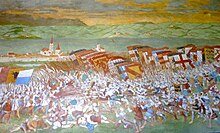Battle Chapel Sempach
The Sempach Battle Chapel stands above the town of Sempach in the canton of Lucerne in Switzerland on the road to Hildisrieden . It was built in 1472/73 to commemorate the Battle of Sempach on July 9, 1386, in which troops from Lucerne and central Switzerland defeated a Habsburg army under Duke Leopold of Austria . The chapel is dedicated to James the Elder .
history
According to a legend, a memorial is said to have been erected at the place where Duke Leopold fell, but this has not been proven. The actual chapel was built in 1472/73. Due to the found layers of plaster, four construction stages will be concluded. During excavations in 1983/84, the remains of a smaller previous building were found that stood in the area of today's choir.
The chapel was renovated in 1551–1554 and heavily redesigned in 1638–1641. In 1747, under sack master Aurelian zur Gilgen (1688–1759), the walls were raised by approx. 50 cm, the windows were raised and the vestibule was added to the west. The chapel received a new roof structure and the previous flat ceiling was replaced by a vaulted one, which in turn was replaced in 1825 by a plaster one. In 1885/86 the chapel was restored again by Heinrich Viktor von Segesser to mark the 500th anniversary of the battle ; Among other things, the roof was covered with colored slate and the side entrances were protected with canopies. The current ceiling was also added. In 1985/86 another restoration took place, during which the previous pointed helmet of the roof ridge was replaced by a curved one. In addition, the side entrance received a new canopy.
On the side walls and the back wall, the names of the fallen Confederates and the coats of arms and names of nobles who fell on the part of the Habsburgs have been listed since 1886 . Among the Confederates, Arnold von Winkelried's name appears as "Erni Winkelried". The Habsburg banners and the names of their bearers are painted on the choir wall. The three altars have no relation to the rest of the furnishings in the chapel. They are not signed and date from the 17th century.
Banners Ochsenstein and Thierstein
Battle painting
The entire north-west wall of the chapel is covered with a monumental representation of the Battle of Sempach. The foreground shows the Confederates on the left, Leopold's army on the right. In the middle, Winkelried pushes the spears to the ground. In the background behind the town of Sempach lies the Sempachersee with the Nottwilerberg, on the left you can see the Pilatus .
It is not clear who originally made the large battle fresco. In the accounts from 1551, work on a picture appears. What it was, however, is unclear, possibly a painting by Hans Rudolf Manuel (1525–1571). 1638–1643, on the occasion of the redesign of the chapel at that time, a major overhaul, if not a new painting, took place, probably by painters from the circle of the Lucerne painter Hans Ulrich Wägmann.
In 1747 the chapel was raised by 50 centimeters and the painting above was added. In 1695 and 1741–1743 the picture was restored. Between 1826 and 1886 the fresco was covered with an oil painting by the Willisau painter Xaver Hecht (1757–1836), which can be seen today in the Sempach festival hall.
In 1886, on the occasion of the 500-year jubilee, Josef Balmer (1828–1918) restored and added to the picture; at the bottom left he names Wägmann as the painter. A renewed restoration in 1985 showed that there were two more layers of paint under the current layer of plaster, one colored and one in gray.
Ossuary and cross
The small ossuary from 1594 contains bones that are said to have come from those who died in the battle . However, an investigation found that the bones are more recent. A stone cross in front of the church marks the place where the Lucerne schoolboy Petermann von Gundoldingen is said to have fallen. Together with two other crosses, it was the station of a procession that is held for the fallen on the last Saturday in June during the battle season . The Pietà dates from the beginning of the 16th century and is carved from a single piece of linden wood.
literature
- Rainer Hugener: The Changing Place of Remembrance. The Sempach battle commemoration in the Middle Ages and in the early modern period, in: Der Geschichtsfreund. Journal of the Historisches Verein Zentralschweiz 165, 2012, pp. 135–171.
- Martin Steger and Josef Fink: The Battle Chapel of Sempach , Sempach 1999.
Web links
- Battle chapel on sempach.ch
Individual evidence
- ^ Frank Hieronymus: Hans Rudolf Manuel. In: Historical Lexicon of Switzerland . October 27, 2009 , accessed June 7, 2019 .
- ↑ Culture Guide Switzerland, Ex Libris-Verlag, Zurich 1982.
Coordinates: 47 ° 8 '45.7 " N , 8 ° 12' 43.8" E ; CH1903: 658 673 / 221.96 thousand










